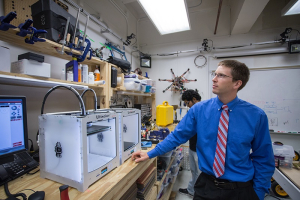The same technology that powers MRI scanners to see inside your body may soon be used to deliver targeted treatments for a variety of diseases and conditions. Electrical and computer engineering Assistant Professor Aaron Becker’s research, now published in Scientific Reports, uses magnetic fields to move tiny magnetic particles around to deliver chemotherapy to the precise locations of tumors seen in MRI images.
“One challenge is that the MRI is using the magnetic coils to take images, so using the coils to push particles around prevents you from doing imaging — you can either see or move, but not both at once. This slows down both movement and the imaging process,” said Becker.
His team’s breakthrough came when they realized that they could change some variables in a normal imaging sequence to make the imaging sequence apply forces precisely in the directions he wanted.
“By cleverly modeling the response of these inputs, we can shift imaging parameters and move the magnetic particle at blazingly fast speeds,” said Becker.
In a video accompanying Becker’s research, he steers a particle through a 3D printed maze inside of a clinical MRI scanner. He compares it to a game, although the stakes are a bit higher.
“Much like the game five-finger fillet, where one places the palm of their hand on a table and stabs a knife back and forth between the fingers without touching the fingers, we can quickly move the magnetic particle through the vascular maze,” he said. This medical version of the game has no known risk.
Targeting trouble
Becker says that while significant progress has been made in developing cellular medicines and therapeutic drugs, techniques for targeted delivery have not proceeded apace.
“While localized delivery is sometimes possible, systemic injection remains the best option for deep-seated targets or for multiple targets dispersed through the body,” said Becker.
With systemic injection of chemotherapy agents, anti-cancer drugs are either injected into the vein or taken by mouth in pill-form. The drugs then travel through the bloodstream, subjecting healthy tissues throughout the body to the toxic effects of the chemotherapy cocktail.
In addition to causing debilitating side effects in patients, systemic administration of cancer drugs carries other important drawbacks. For one, delivering the drugs to a desired location inside of the body, such as the site of a tumor, is nearly impossible. Moreover, the drugs have only a limited circulation time in the body due to the filtering of the blood by the lungs, spleen and kidneys.
In Becker’s method, the same MRI used to detect the tumor will steer the magnetized medicine to the desired point, representing a promising approach to take on the challenges.
Like the breakthrough itself, Becker’s work both propels treatment options and mirrors a great future in treating tumors.
